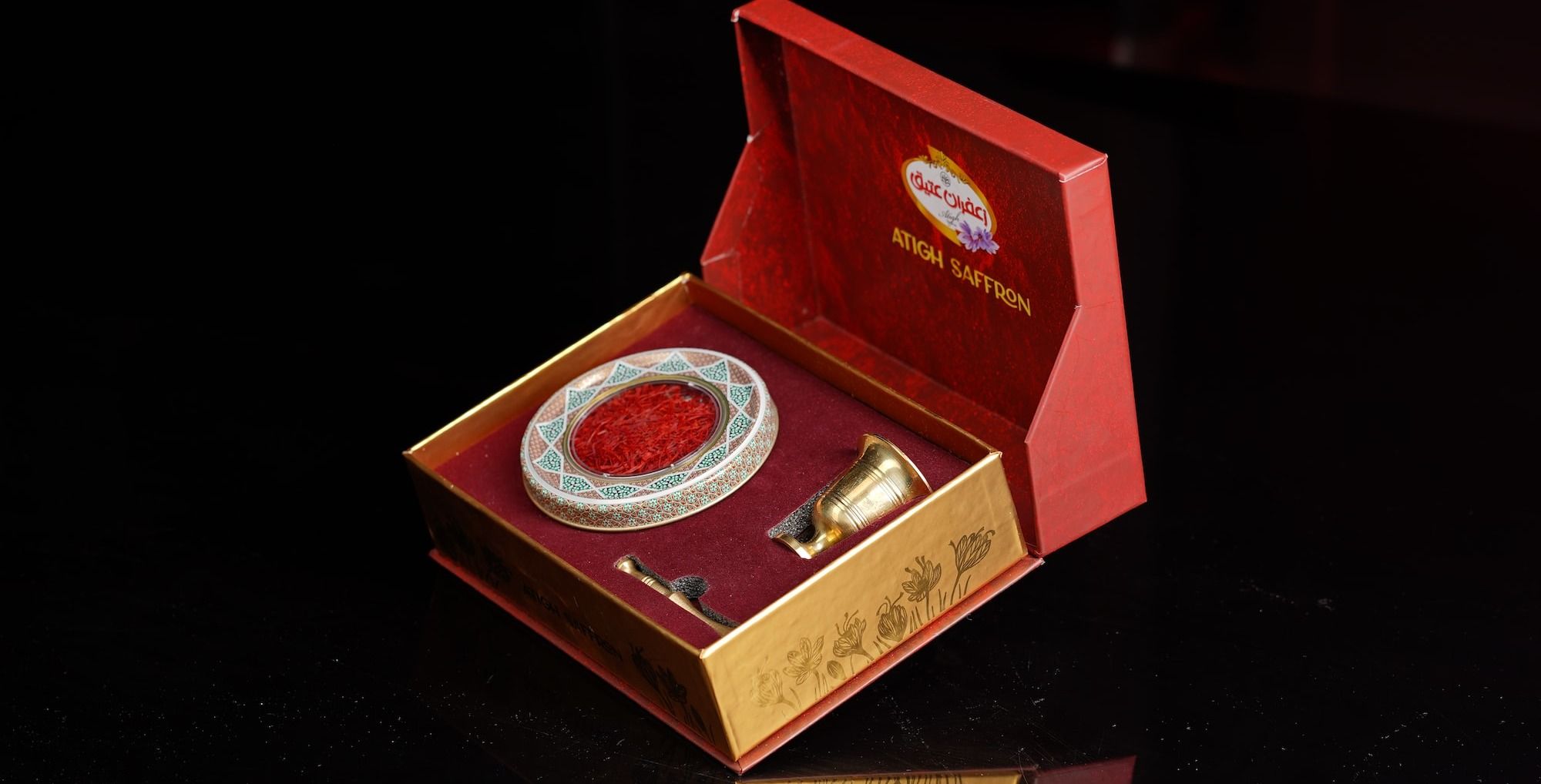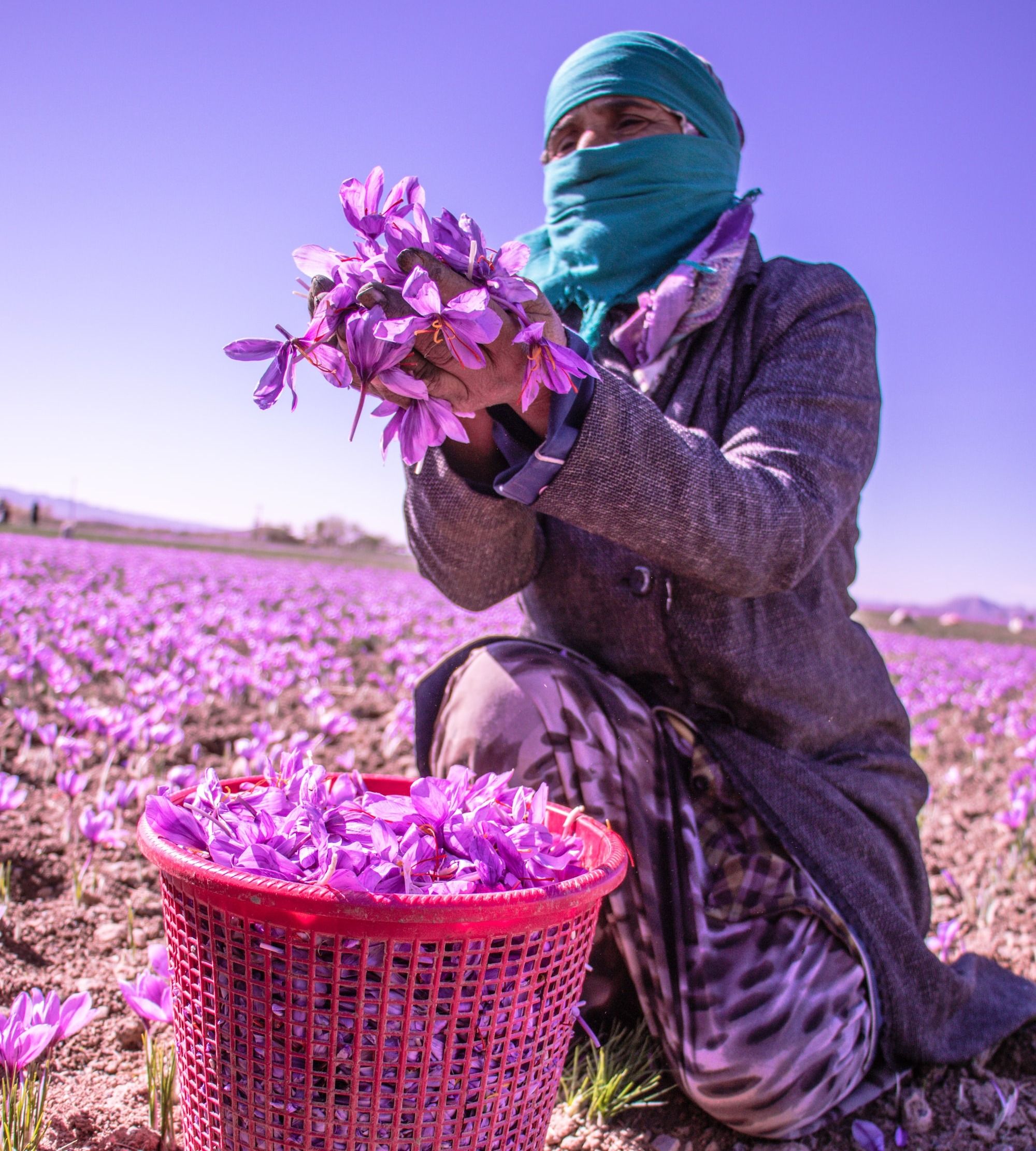Why Is Saffron So Expensive?
Here's Everything You Need To Know Why Saffron Is So Expensive

What is Saffron?
Saffron, referred to as kesar in India, is a treasured spice obtained from the Crocus sativus flower, also known as the "saffron crocus."
Famous for its bright red stigma and styles, these parts are harvested and dried to be utilized as a flavoring, food coloring, and for medicinal applications.
Iran, India, and Spain lead the world in saffron production, with other nations like Greece, Morocco, Italy, Azerbaijan, Turkey, and Afghanistan also engaging in the cultivation of this valuable spice.
Among these, the saffron harvested in India's Kashmir region is particularly noteworthy, both for its superior quality and its extravagant cost.

How Much Does Saffron Cost?
The cost of a kilogram of saffron's crimson threads could reach a staggering $10,000, marking it as a spice far beyond the reach of ordinary budgets.
The saffron trade has become so profitable that it has led to a surge in counterfeit and tainted varieties in the market.
According to the European Institute of Innovation and Technology, there are instances where only 10% of a sample is genuine saffron, the rest being composed of dyed imitations like cornsilk or safflower.
The immense value of this crop has evidently enticed many to seek profit from it.
Which Is The Best Saffron In The World?
Kashmir Saffron from India stands paramount on our list, globally revered for its profound deep red hue, potent aroma, and robust flavor.
The deep, vibrant red threads signify its superior quality, while its intense fragrance, embodying floral, earthy, and mild sweet notes, enriches dishes with complexity.
The Reason Why Saffron is So Expensive
This inevitably prompts one to question, "What makes saffron so expensive?" The explanation is quite fascinating.

Incredibly Labor-Intensive Crop to Harvest
Growing saffron starts with picking the purple crocus flowers. Each flower has three parts: the petals, the yellow strands, and the red strands called stigmas.
Saffron is made from these red stigmas. There are only three stigmas in each flower.
Harvesting these threads is a labor-intensive process, as it must be done by hand. It requires careful and delicate plucking to ensure the threads aren't damaged.
The saffron crocus flowers only bloom for six weeks each year, from the end of September to the beginning of December.
They need to be picked early in the morning so that the sun doesn't harm them. Getting just one kilogram of saffron takes 160,000 flowers. It's a lot of work and takes a lot of time
Large Land Area Required
Although each Crocus sativus flower only produces three saffron threads, the plant itself requires a significant amount of space to grow.
Each Crocus sativus flower yields only three saffron threads. However, despite the seemingly minuscule yield per flower, the plant requires ample space to grow healthily.
This spacing ensures that each flower has access to enough nutrients and sunlight, reducing competition and promoting a more bountiful harvest.
To put this into perspective, a hectare of land, which is roughly equivalent to 90% of a football field, can yield about 2 kilograms of pure saffron threads in one year.
Given that each flower produces only a tiny amount of saffron, it becomes evident just how many flowers are needed to produce even this modest weight.
This means that vast tracts of land are cultivated for what seems like a small return in terms of the final product, further emphasizing the premium placed on saffron's value and contributing to its high price.
High Demand, Challenging Saffron Supply
The decline was linked to several factors including a low benefit-cost ratio, demanding and costly farming methods, and low productivity (yielding only 2 kg per hectare).
Additionally, stresses from living organisms (biotic) and non-living factors (abiotic), poor plant conditions, and changes in weather that cause a lack of moisture during vital growth periods contributed to the issue
Short Harvesting Season
The flowering period for saffron crocus is brief, spanning just six weeks annually from late September to early December.
To protect the delicate blooms from the sun's damaging rays, they must be harvested during the early morning hours.
The farmers have a very limited timeframe to harvest, which can be challenging, especially if they face adverse weather conditions.
After the saffron threads are harvested, they need to be dried. This process reduces the weight of the spice by almost 80%, meaning that many more flowers are required to produce a small amount of usable saffron.
The drying must be done correctly to preserve saffron's distinct flavor, aroma, and color.
Environmental Factors That Might Affect Its Growth
The farming of saffron in Kashmir has become a precarious endeavor because of high temperatures, droughts, and prolonged spells of extreme heat.
The Indian state of Kashmir produces the world's best and most expensive saffron, selling for more than $1,500 a pound. (Yes, that's the actual price.)
What's more, the cost of Kashmiri saffron is expected to rise even further in the future due to climate change.
These challenging conditions have led farmers to sell substantial portions of their land to real estate developers, making the spice even more scarce and potentially driving up its price.
In a 2021 study named "Agro-Climatic Suitability Evaluation for Saffron Production in Areas of Western Himalaya," published by Frontiers, researchers found that saffron grows best in a special kind of soil.
The soil should be loose and crumbly, not packed tightly together, and it should be watered well but also able to drain so it's not too wet.
The best soil for saffron has a pH level between 6.8 and 7.8, and it also needs to have the right amount of electric conductivity.
The quality of saffron is determined by the conditions of the environment and the specific substances found within it.
Saffron's Medicinal Chemical Components
Scientists and growers around the world agree that the main reason Kashmir saffron is so expensive is because of its excellent quality, shown by its dark maroon-purple color.
This unique color is due to a higher amount of crocin, a type of pigment. Crocin gives saffron its darker color, enhanced flavor and also greater medicinal properties.
Because of these reasons, it is easy to understand why a small bottle of saffron costs so much!
Fortunately, you only need a small amount of saffron to flavor a dish, as using too much can make the food taste bitter.
Popular Dishes Prepared by Chefs Using Saffron
- Paella Valenciana: A traditional Spanish rice dish combined with various meats and sometimes seafood. The saffron imparts a unique flavor and a beautiful golden hue to the rice.
- Risotto alla Milanese: An Italian creamy rice dish, where the saffron lends a delicate aroma and a bright yellow color to the risotto.
- Bouillabaisse: A classic French seafood stew originating from Provence, accentuated with a saffron-infused broth.
- Saffron Chicken or Kesar Murgh: Often found in Indian cuisine, it's a dish where chicken is marinated with yogurt, spices, and saffron, then cooked until tender.
- Tahchin: A Persian layered rice cake, often filled with chicken, beef, or lamb, and flavored generously with saffron.
- Saffron Buns or Lussekatter: A Swedish treat, these are sweet, yeasted buns infused with saffron, traditionally enjoyed during St. Lucia's Day.
- Kesar Pista Kulfi: An Indian ice-cream variant where the creaminess of the kulfi is complemented by the aroma of saffron (kesar) and the crunch of pistachios.
- Mughlai Biryani: An aromatic rice dish from the Indian subcontinent, layered with meat and saffron-infused milk, often garnished with fried onions and boiled eggs.
Summary
The high cost of saffron is largely a reflection of the intensive labor required for its cultivation, the limited regions where it can be grown, its delicate nature, and the post-harvest processes needed to maintain its quality.
Frequently Asked Question
How Much Can Saffron Yield Per Hectare?
Saffron stands out globally as the sole spice priced per gram. In optimal farming conditions, and depending on the quality of corms, a hectare of saffron land yields between 1.5 and 2 kg of the spice. Approximately 150 flowers are required to produce a gram of dried saffron. When cultivated proficiently using high-quality corm planting, it takes around 150,000 robust flowers to harvest a kilogram of dried saffron threads.
How To Tell If Saffron Has Gone Bad?
Determining the freshness of your saffron is crucial due to its unique flavor, hue, and scent. Here's a guide to help you ascertain if your saffron is still top-notch or if it's time to let it go:
· Review the Sell-By or Harvest Date:
The sell-by date can hint at the freshness of your saffron. If it's been three years post this date, your saffron may have lost its vibrancy and it might be wise to dispose of it. Another hint of freshness can be the harvest date on the packaging. The closer your possession is to this date, the more potent and fresh it likely is.
· Assess the Color:
Fresh saffron boasts a radiant orange-red shade. This vivid hue, combined with its deep undertones, is a significant part of its appeal. If your saffron, whether powdered or threaded, appears pale or has lost its bright tint, it might not offer the desired results in your dishes.
· Evaluate the Scent:
The unmistakable scent of saffron includes notes of tobacco, mingled with strong floral and earthy undertones. To gauge its freshness, take a bit and rub it between your fingers. This will release its scent. If the aroma is faint or non-existent, the saffron may be past its prime.
· Inspect for Moisture:
Powdered saffron can be vulnerable to moisture. Should there be moisture, you'll notice the powder forming lumps, while threads may clump together instead of being distinct strands. Damp saffron can also lead to mold growth, which is both unappetizing and unhealthy.
By following these steps, you can ensure that the saffron you use is fresh, potent, and ready to elevate your dishes.
How To Store Saffron Effectively?
Storing saffron doesn't necessitate extravagant containers or intricate methods, but certain conditions are essential for maintaining its quality. Here's a guide to correctly preserving this prized spice:
1. Refrain from Refrigeration: It may seem counterintuitive, but keeping saffron in the fridge can harm it. The humidity within the refrigerator can cause saffron to deteriorate or mold, especially since the spice is highly susceptible to moisture.
2. Opt for a Pantry or Cupboard: A dark, cool, and dry pantry or cabinet is the ideal place for saffron. While many retailers display saffron in transparent jars, this can expose the spice to light, compromising its quality. To best preserve its essence, keep saffron in a sealed container, shield it from light using aluminum foil, and position it in a cool, shadowed spot away from any direct heat sources.
3. Maintain Consistent Temperatures: Saffron thrives in stable conditions. A temperature range of 15-20°C and humidity around 40% is optimal. If you have access to a climate-controlled storage space, this can further prolong the freshness and potency of your saffron and other spices.
4. Divide into Manageable Portions: If you've purchased saffron in bulk, consider separating it into smaller airtight containers. This method ensures you only expose what you intend to use, minimizing the spice's contact with air and moisture, which can degrade its quality.
Additional Considerations:
- Consider purchasing whole saffron threads and grinding them as needed. Threads tend to retain their aromatic and flavor profiles longer than the powdered version.
- Always source your saffron from a trustworthy supplier to ensure its purity and avoid potential adulterants like turmeric.
- When cooking, avoid placing the saffron container directly over steamy pots or dishes. The steam's moisture can seep into the container, jeopardizing the spice's integrity.
By following these storage guidelines, you can enjoy the rich essence of saffron for a longer duration without any compromise in quality.


